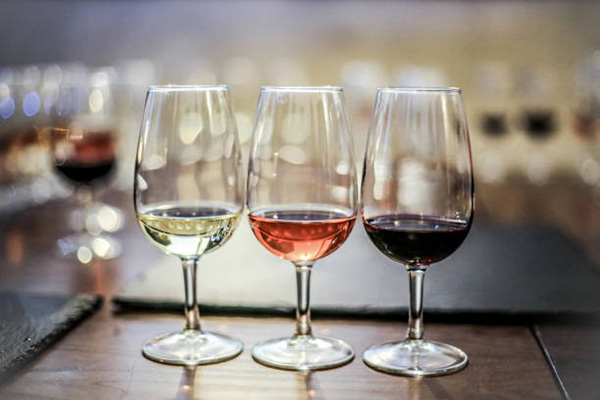WINE TASTING
Tasting a wine means comparing it in terms of quality with other wines. In order to do that, one should know the technique of tasting, should recognize the components that compose the qualitative potential of a wine and finally, should keep in their flavor memory the characteristics of as many types of wine as possible and especially of those that are universally considered as of high quality.
Wine tasting includes the description of the color, the aroma by the nose, the description of the flavor by the mouth and finally the aromatic sensation it leaves when it is no longer in the mouth. The sense of the quality is a point of aesthetics, and this is the reason why it changes with the pass of the centuries and it is difficult to be described. Briefly, the quality of a wine is connected with the intensity and the complexity of the aroma, the flavor richness it leaves in the mouth and the long duration of its aroma.

THE SENSE OF VISION
The observation of the color and the exact tone of the wine is achieved by placing it in a glass which is put at an angle, in front of a white surface. Clean and strong light is necessary. A “white” wine, which liberates from its body green reflections, seems young and has avoided any kind of oxidation. The intensity of the yellow indicates the maturity, the age, the flavor richness, and the staying of the wine in the barrel. The color is also a valuable guide for the identification of the age of the red wines. Blue tones indicate a much younger wine. Tile-colored and brown tones show the wine’s aging, which is as old as the proportion of these tones in it. A wine’s lucidity is considered to be inseparably connected with its quality.

THE SENSE OF VISION
The observation of the color and the exact tone of the wine is achieved by placing it in a glass which is put at an angle, in front of a white surface. Clean and strong light is necessary. A “white” wine, which liberates from its body green reflections, seems young and has avoided any kind of oxidation. The intensity of the yellow indicates the maturity, the age, the flavor richness, and the staying of the wine in the barrel. The color is also a valuable guide for the identification of the age of the red wines. Blue tones indicate a much younger wine. Tile-colored and brown tones show the wine’s aging, which is as old as the proportion of these tones in it. A wine’s lucidity is considered to be inseparably connected with its quality.

THE SENSE OF SMELL
The aroma of a wine is divided in primary, which comes from the aromatic substances contained in grapes and in secondary, which comes out during the fermentation, while the yeasts transform the sugar of the must into alcohol, producing at the same time aromatic combinations. There is also the tertiary aroma and the bouquet that are developed later during the stage of the maturity and the aging of the wine. The wine taster must smell the wine before putting it in their mouth. This is why the direct line of smell through the nose is used.
This is the nasal smell or the direct line of smell, which gives the sense of the aroma.
The stirring of wine in the tasting glass liberates more smells and increases the aromatic sense, allowing at the same time the appearance of more smells that derive from “heavier” aromatic components. What we feel when the wine is in the mouth does not concern only the flavor, but also, to a great extent, the aroma, that one can recognize through the line mouth-centre of smell (or indirect line of smell or aroma of the mouth). The taster tries to distinct the intensity of the aroma and its special characteristics. After a careful examination, we are able to identify, within the aromatic whole, an aroma that brings to mind the familiar perfume of a flower or a fruit, the perfume of a dried fruit or a type of wood. A good wine should have intensive, delicate and, at the same time, complex aromatic character.
The basic presupposition for a good wine is the absence of any odors alien to the wine, such as that of sulphur dioxide (a wine’s preservative), which, when in abundance, apart from the direct effects of irritation, eliminates a big part of the wine’s aromas. The oxidation aromas (that smell like an apple), the hydrogen sulphide (bad egg), the mould etc, are odors that indicate a mediocre or bad wine. In sour wines (after the activation of the bacteria of the acetic fermentation), there is plenty of acetic acid (vinegar’s aromas), which together with the ethyl acetate produced (seems like cola stick) covers all the aromas and of course in this case the wine is not “drinkable”.

THE SENSE OF SMELL
The aroma of a wine is divided in primary, which comes from the aromatic substances contained in grapes and in secondary, which comes out during the fermentation, while the yeasts transform the sugar of the must into alcohol, producing at the same time aromatic combinations. There is also the tertiary aroma and the bouquet that are developed later during the stage of the maturity and the aging of the wine. The wine taster must smell the wine before putting it in their mouth. This is why the direct line of smell through the nose is used.
This is the nasal smell or the direct line of smell, which gives the sense of the aroma.
The stirring of wine in the tasting glass liberates more smells and increases the aromatic sense, allowing at the same time the appearance of more smells that derive from “heavier” aromatic components. What we feel when the wine is in the mouth does not concern only the flavor, but also, to a great extent, the aroma, that one can recognize through the line mouth-centre of smell (or indirect line of smell or aroma of the mouth). The taster tries to distinct the intensity of the aroma and its special characteristics. After a careful examination, we are able to identify, within the aromatic whole, an aroma that brings to mind the familiar perfume of a flower or a fruit, the perfume of a dried fruit or a type of wood. A good wine should have intensive, delicate and, at the same time, complex aromatic character.
The basic presupposition for a good wine is the absence of any odors alien to the wine, such as that of sulphur dioxide (a wine’s preservative), which, when in abundance, apart from the direct effects of irritation, eliminates a big part of the wine’s aromas. The oxidation aromas (that smell like an apple), the hydrogen sulphide (bad egg), the mould etc, are odors that indicate a mediocre or bad wine. In sour wines (after the activation of the bacteria of the acetic fermentation), there is plenty of acetic acid (vinegar’s aromas), which together with the ethyl acetate produced (seems like cola stick) covers all the aromas and of course in this case the wine is not “drinkable”.

THE SENSE OF FLAVOUR
The wine is a solution of water and alcohol which contains acids, sodiums, phenolic compounds (tannins and anthocyanins) sugars, esters and many other substances. Each one of them has flavor that corresponds to one of the four basic flavors. The basis of the flavor balance in wine is the balance of two flavor groups. On the one hand, the ingredients of sweet flavor (alcohol, sugars) and on the other hand, acids and tannins, which represent the sour and bitter flavors. In the group of wine’s ingredients of sour flavor we can add the carbon dioxide. A small amount of CO2 offers a fresh, lively flavor, while, when in large quantity, it is noticeable by the pinching and the numbing that provokes to the external edge of the tongue. Regarding the acrid sense that is mainly present in red wines, we can say that the red wine contains phenolic compounds, a group of which are the tannins, which have a bitter flavor and at the same time they give this acrid sense to the wines that contain them. This sense is the outcome of a chemical reaction which is resulted from the joining of the tannins with the proteins of the saliva. The phenolic substances derive from the solid parts of the grapes peel, from the bunch and the kernels. They are responsible (mainly in red wines) for the difference of the flavor quality between two wines. Not all the wine’s tannins have the same chemical composition. In a qualitative red wine, tannins are soft and flexible and they contribute to its rich tannic character, to its volume and body. In the contrary, in another wine the presence of tannins of bad quality (acrid and aggressive) destroys any flavor character it may has and undermines it in terms of quality. Wine aging, by the modification of the tannins polymerism, improves their flavor character, either because it makes them softer, either because it immerses them. Therefore, if the wine is suitable for aging, then it is upgraded in terms of quality.

THE SENSE OF FLAVOUR
The wine is a solution of water and alcohol which contains acids, sodiums, phenolic compounds (tannins and anthocyanins) sugars, esters and many other substances. Each one of them has flavor that corresponds to one of the four basic flavors. The basis of the flavor balance in wine is the balance of two flavor groups. On the one hand, the ingredients of sweet flavor (alcohol, sugars) and on the other hand, acids and tannins, which represent the sour and bitter flavors. In the group of wine’s ingredients of sour flavor we can add the carbon dioxide. A small amount of CO2 offers a fresh, lively flavor, while, when in large quantity, it is noticeable by the pinching and the numbing that provokes to the external edge of the tongue. Regarding the acrid sense that is mainly present in red wines, we can say that the red wine contains phenolic compounds, a group of which are the tannins, which have a bitter flavor and at the same time they give this acrid sense to the wines that contain them. This sense is the outcome of a chemical reaction which is resulted from the joining of the tannins with the proteins of the saliva. The phenolic substances derive from the solid parts of the grapes peel, from the bunch and the kernels. They are responsible (mainly in red wines) for the difference of the flavor quality between two wines. Not all the wine’s tannins have the same chemical composition. In a qualitative red wine, tannins are soft and flexible and they contribute to its rich tannic character, to its volume and body. In the contrary, in another wine the presence of tannins of bad quality (acrid and aggressive) destroys any flavor character it may has and undermines it in terms of quality. Wine aging, by the modification of the tannins polymerism, improves their flavor character, either because it makes them softer, either because it immerses them. Therefore, if the wine is suitable for aging, then it is upgraded in terms of quality.



